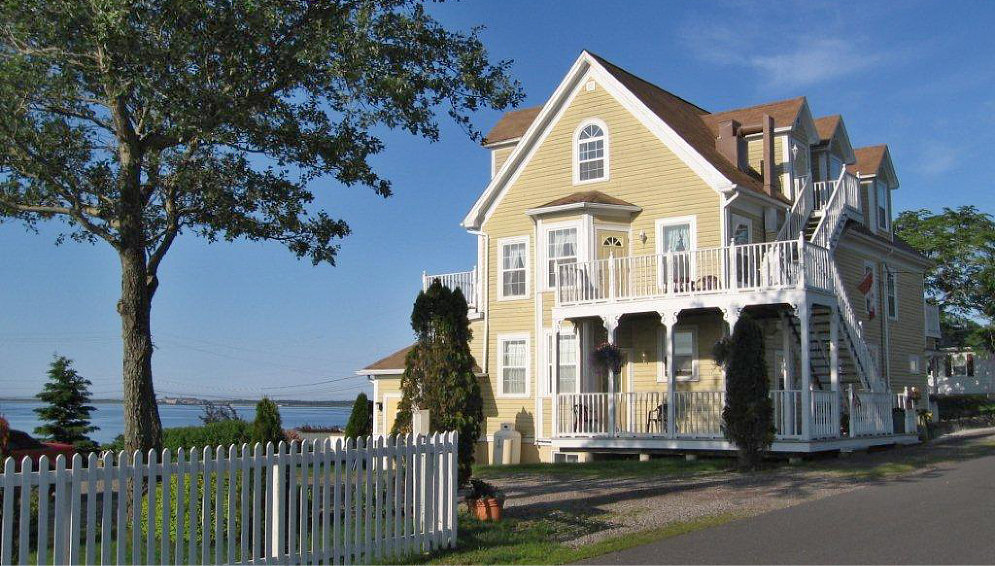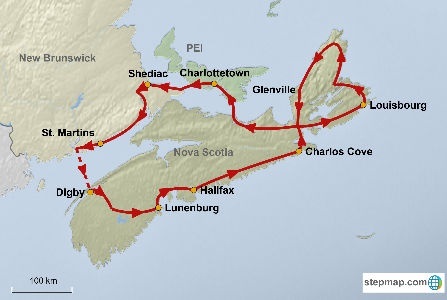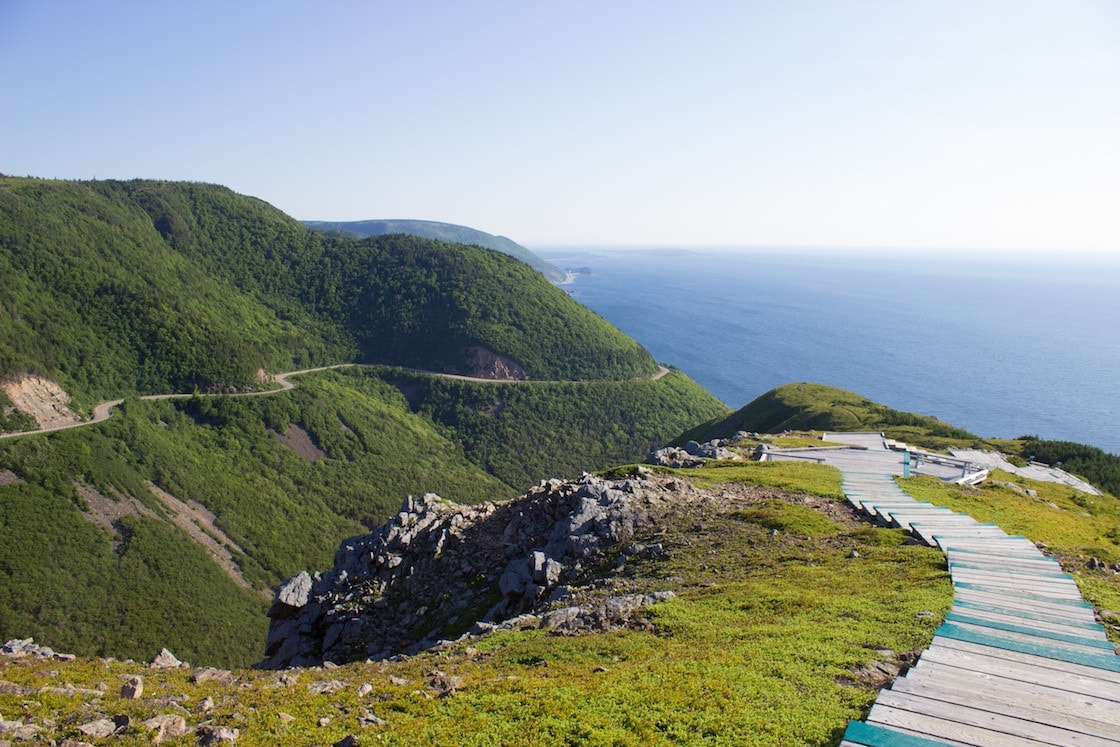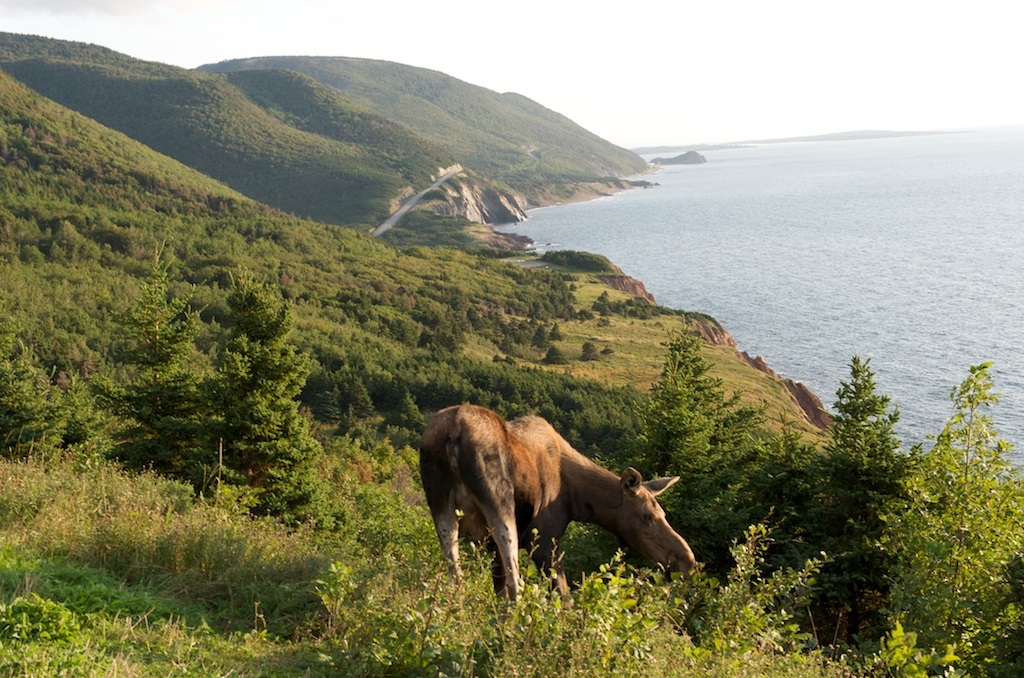Day 1: Arrival in Halifax
This is Canada’s traditional gateway to the world, combining charming old wooden homes and Victorian parks with modern shopping centres. The largest city in the region, it is home to 5 universities and several colleges and has the ambience of a lively university town. Ships, from tall ships to naval vessels, can still be seen in the harbour, and old warehouses and shipfitters’ shops have become part of the exciting boardwalk along the waterside.
Day 2: Halifax – Charlos Cove/Sherbrooke (ca. 300 km)
As you follow Marine Drive several parks provide sandy beaches and wild seascapes of rocky islands. En-route, why not visit Sherbrooke Village – one of the largest “living museums” in the Maritimes which has been partially restored to its frontier days.
Day 3: Charlos Cove/Sherbrooke – Louisbourg (ca. 240 km)
Today you may want to explore some of the most rugged and isolated parts of Nova Scotia’s coast, including the tiny fishing village of Canso, before crossing to Cape Breton Island by causeway and arriving at your destination.
Day 4: Explore Cape Breton Island
A day at leisure to explore the attractions of the Island, including Bras d’Or Lake, Canada’s inland salt sea, wild seabird colonies and Fortress Louisbourg, Canada’s largest National Historic Site, and the strongest French fortress ever built in the Americas. Between June and September, costumed “animators” live in the fortress, making it come alive as it was in the summer of 1744.
Day 5: Louisbourg – Margaree/Mabou (ca. 300 km)
The Cabot Trail is one of Canada’s best loved scenic drives and follows the impressive coastline from sea level up to an alpine plateau 500m above the sea.
Waterfalls and swift running streams can be found near the road, and opportunities for seeing moose are excellent. Whales can often be spotted from the walking trails which overlook the coast. You may wish to take in an optional afternoon whale-watching cruise from Cheticamp.
Day 6: Margaree/Mabou – Charlottetown (ca. 330 km)
Drive through the scenic hardwood hills of Eastern Nova Scotia, where it seems every little roadside stream has been dammed by beavers. Visit the historic town of Pictou, where the Scots first landed in New Scotland (Nova Scotia). A 75 minute ferry trip brings you to Prince Edward Island, Canada’s smallest province. The colour contrasts of red soil, green fields & forests and blue sky and ocean make for wonderful holiday pictures.
Day 7: Explore Prince Edward Island
Explore historic Charlottetown – Province House National Historic Site, Victoria Row or the Confederation Centre of Arts, or enjoy some of Canada’s best beaches – ideal for recreation, long lonely hikes and the observation of wildlife, all within a short drive of the city.
Day 8: Charlottetown – Shediac/Sackville(ca. 200 km)
A 13km-long crossing of the Northumberland Strait on the “Confederation Bridge” brings you to New Brunswick. Walking trails and a viewing platform at the Cape Jourimain Nature Centre let you view the bridge and a National Wildlife Area. Explore the Acadian Coast of the region.
Day 9: Shediac/Sackville – St. Martins (ca. 230 km)
Fundy National Park, 206sq.km in area, is a sanctuary of steep coastal cliffs and clear streams, with ocean-side forests, green meadows, sparkling rivers and gorgeous hiking trails. The Hopewell tidal experience site (a Provincial Park) is the best place to witness and understand the tides. Iron stairs lead down the cliffs to the beach and at low tide you can walk through nearby Hopewell Rocks, shaped like giant vases, which are almost covered by the tide every six hours; a large clock warns you to leave as the tide comes in. Continue through Fundy National Park with its forest drives and sparkling waterfalls to the fishing village of St. Martins.
Day 10: St. Martins – Digby (ca. 100 km excl. ferry)
If nature is your desire, explore the beginnings of the Fundy Trail Parkway, with high quality walking paths and striking viewpoints over the wild coast, right next door to your inn. If you like more sophisticated attractions, spend the morning in Saint John. Saint John was founded in 1783 by refugees from the United States who wished to remain citizens of the British Empire. These “Loyalists” created a new city in the wilderness, and their descendants have proudly preserved the heritage and architecture of the period. Visit the Old City Market or experience the Reversing Falls (located in an industrial area). A ferry (included) takes you from Saint John, New Brunswick to Digby, Nova Scotia carrying you across the Bay of Fundy. Watch for whales and seabirds on the 3hrs crossing.
Day 11: Digby – South Shore/Mahone Bay (ca. 200 km)
The Annapolis Valley is the oldest settled part of Canada and the lushest agricultural area of Eastern Canada. This is reflected in the ornate, aristocratic wooden houses common to the area, a result of the 300 years of prosperity farmers and forest owners have enjoyed here.
One of the best examples is Annapolis Royal, the oldest continuously settled town in Canada. Drive through inland Nova Scotia and stop at Kejimkujik National Park which contains 380sq.km of forests, lakes and rivers.
Rock drawings and an Indian graveyard are illustrations of an Indian life here that goes back almost 5000 years. The park is home to the greatest diversity of reptiles and amphibians in Atlantic Canada. Take a picnic lunch and enjoy a walk through a 400-year old hemlock stand or try canoeing on North America’s oldest canoe routes.
Travel onwards to Nova Scotia’s beautiful South Shore!
Day 12: Lunenburg/South Shore
There is much on offer in this area. Lunenburg, first settled in 1753 is a rustic Nova Scotia fishing port with many ties to the “age of sail”, and wooden sailing ships are still built in this area. The old part of Lunenburg still preserves its original town plan and unique architecture, and has been recognized by UNESCO as a World Heritage Site. Mahone Bay, settled in 1754 with its much photographed heritage homes with original architecture and the iconic “three churches” is a small town where almost everything is within walking distance.
Day 13: South Shore/Mahone Bay – Halifax (ca. 150 km)
Rocky harbours with hidden bays and islands have made Nova Scotia’s south shore a pirate’s and smuggler’s paradise for over 300 years. On the last stretch of your trip take the scenic coastal road and visit the elegant Chester and much photographed Peggy’s Cove, to name but a few of the attractive coastal villages you pass as you return to Halifax.
Day 14: Departure
Today you journey to Halifax Stanfield Airport for your departure.













